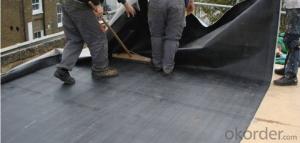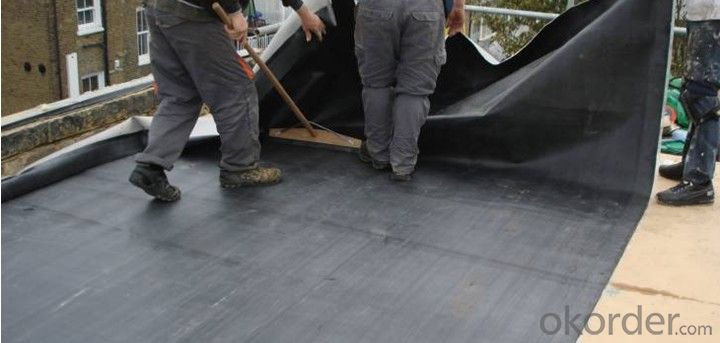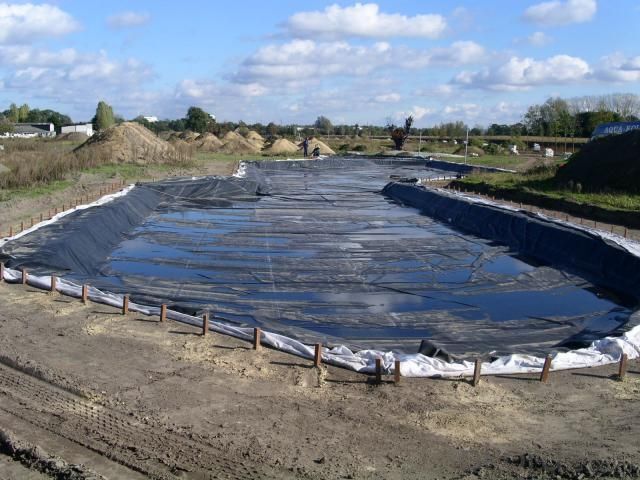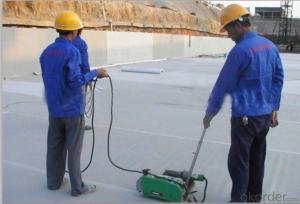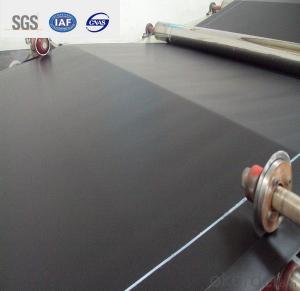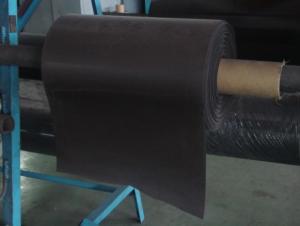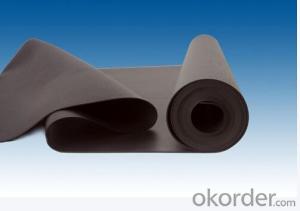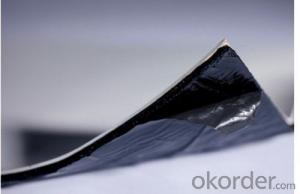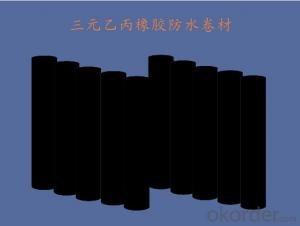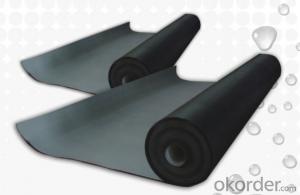EPDM Waterproofing Membrane for Roof Only
- Loading Port:
- Shanghai
- Payment Terms:
- TT OR LC
- Min Order Qty:
- 50000 m²
- Supply Capability:
- 5000000 m²/month
OKorder Service Pledge
OKorder Financial Service
You Might Also Like
EPDM Waterproofing Membrane for Roof Only
Description Of EPDM Waterproofing Membrane for Roof Only:
This waterproof coiled material is of high elasticity with best performance among high polymer waterproof coiled material in the world.It is also the most typical one in the world.Waterproof coiled material made of ternary ethylenepropylene rubber of KINTOPbrand is produced with the use of the most advanced continuous extrusion and vulcanization technology and related equipments which are specially designed for production of such product.It is good in compactness,without bubble and performance difference in length and breadth.
Main Features of EPDM Waterproofing Membrane for Roof Only:
1>Excellent anti-aging performance, service life up to 50 years
2>Working well with in -40°C to 100°C,it can be constructed with a single layer in ambient temperature.
3>Waterproofing on various kinds of underground project,industrial of civil buildings and structures.
4>high extension rate, high tensile strength, small size changes at heat treatment
5>Good plant roots penetrability resistance and can be made waterproofing layer of planting roof
6>Special modified molecular structure ,effectively resolving the current domestic and foreign glue
joint problem .
7>Good low temperature flexibility, and good performance of adapting to ambient temperature
changes.
8>Convenient application ,solid joint, no environment pollution
9>chemical corrosion Resistance, can be used for special occasions
Specifications of EPDM Waterproofing Membrane for Roof Only:
Type | EPDM Rubber Waterproof Membrane | ||
Type | Vulcanized and Weldable | ||
Thickness | 1.2mm | 1.5mm | 2.0mm |
Weight(kg/m2) | 1.54-1.58 | 1.79-1.83 | 2.25-2.29 |
Size | 1.2m (width) * 20m (length)/roll. Weldable type could be 4m wide. | ||
Packing | 24㎡/roll, with plastic bag. (Weldable: 80㎡/roll) | ||
Usage | Roof, basement, pond, Lake, steel structure roofing, underground, tunnel, etc | ||
NO. | Item | Unit | Technical requirement | |
1 | Tolerance on size | Thickness | % | ±10 |
Width | % | ±1 | ||
length | % | Does not allow negative | ||
2 | Fracture tensile strength (normal temperature ) | Mpa | ≥7.5 | |
Fracture tensile strength(60 ℃) | Mpa | ≥2.3 | ||
3 | Breaking elongation,(normal temperature ) | % | ≥450 | |
Breaking elongation,(-20 ℃) | % | ≥200 | ||
4 | Tearing resistance | KN/m | ≥25 | |
5 | Impermeability | * | 0.3Mpa impermeable | |
6 | Bending at low temperature | °C | ≤-40 | |
7 | Elongation and contraction volume at heating | Elongation | mm | ≤2 |
contraction | mm | ≤4 | ||
8 | Hot air aging 80°CX168h | Fracture strength retention | % | ≥80 |
Rate of elongation at break | % | ≥70 | ||
9 | Alkaline (saturated Ca(OH)2 solution normal Temperature x2 168h ) | Fracture strength retention | % | ≥80 |
Rate of elongation at break | % | ≥80 | ||
10 | Ozone aging (40 degree by 168 hours ) | Elongation 40% , 500x10-2 | * | No Crack |
11 | Phytotron aging | Fracture strength retention | % | ≥80 |
Rate of elongation at break | % | ≥70 | ||
Applications of EPDM Waterproofing Membrane for Roof Only:
Widely used in roofs, basement, toilet ,swimming pool, and all kinds of industry and civil building waterproofing, reservoir, vivicism, bridge, underground, tunnel and dam waterproofing ,especially to the keystone waterproofing projects which is durability, high corrosion resistance and easy deformation.
Construction Site of EPDM Waterproofing Membrane for Roof Only:



IMages of EPDM Waterproofing Membrane for Roof Only:




FAQ of EPDM Waterproofing Membrane for Roof Only:
1. What are we supplying?
We are specialized in producing Colorful Asphalt Roof Shingle, SBS/APP modified bitumen waterproof membrane, Self adhesive bitumen waterproof membrane, PVC waterproofing membrane, EPDM rubber roofing membrane, Single Component Polyurethane Waterproof Coating, and Spray Polyurea Waterproof Coating
.
2. How Many years experience do we have?
We have been exported to more than 20 countries in the past 15 years.
3. How long do we usually reply your request?
We always reply our customer within 24 hours.
- Q: Can a waterproofing membrane be applied on any surface?
- A waterproofing membrane can be applied on a variety of surfaces, but it is important to consider the specific characteristics and requirements of each surface before proceeding. While many waterproofing membranes are versatile and can adhere to different materials, it is recommended to consult with a professional or manufacturer to ensure compatibility and optimal performance. For concrete surfaces, waterproofing membranes can be applied to prevent water penetration and protect against moisture damage. These membranes are typically designed to adhere to concrete and provide a barrier against water and vapor transmission. However, it is important to properly prepare the concrete surface by cleaning, repairing any cracks or imperfections, and ensuring a smooth and even substrate for the membrane. Similarly, waterproofing membranes can be applied to masonry surfaces such as brick or stone. These surfaces may require additional preparation, such as removing loose mortar or debris, and may benefit from a primer to enhance adhesion. Additionally, certain types of waterproofing membranes may be more suitable for these surfaces depending on their porosity and texture. Waterproofing membranes can also be applied to wood surfaces, such as decks or balconies, to protect against moisture damage and extend their lifespan. However, it is important to select a membrane specifically designed for wood surfaces as they may require additional flexibility to accommodate the natural movement and expansion of the wood. In summary, while a waterproofing membrane can be applied on various surfaces, it is crucial to consider the specific characteristics and preparation requirements of each surface to achieve optimal results. Consulting with a professional or manufacturer can help determine the most suitable membrane and application method for a particular surface.
- Q: What are the requirements for the storage of waterproofing membranes?
- Waterproof membranes are generally flammable, so the storage area prohibits fireworks.
- Q: Can a waterproofing membrane be used on crawl spaces?
- Yes, a waterproofing membrane can be used on crawl spaces. It can effectively prevent moisture from seeping into the crawl space, protecting it from water damage and potential mold or mildew growth.
- Q: Can a waterproofing membrane be used for a parking garage deck protection?
- Indeed, the utilization of a waterproofing membrane is a viable option for safeguarding the parking garage deck. Designed with the specific purpose of preventing water infiltration and shielding the underlying structure from moisture-related harm, a waterproofing membrane proves to be highly effective in such scenarios. When applied to the parking garage deck, the waterproofing membrane acts as a barrier, effectively preventing water from permeating the concrete and reaching the steel reinforcement beneath. This, in turn, mitigates the risk of corrosion and deterioration, ultimately prolonging the lifespan of the structure and minimizing the need for expensive repairs or replacements. Moreover, the waterproofing membrane offers protection against other potential sources of damage, including oil or chemical spills resulting from vehicular activity. By creating a barrier, it successfully hinders these substances from penetrating the concrete and causing unsightly stains or deterioration. Supplementary to its protective capabilities, the waterproofing membrane enhances the overall durability and strength of the parking garage deck. It aids in the reduction of cracking, spalling, and other forms of concrete damage that may arise due to freeze-thaw cycles, temperature fluctuations, or heavy loads. All in all, opting for a waterproofing membrane to safeguard the parking garage deck is a highly recommended solution for ensuring the longevity and structural integrity of the facility. By providing a dependable defense against water infiltration, chemical spills, and other potential sources of damage, it serves to decrease maintenance expenses and extend the lifespan of the parking garage deck.
- Q: Can a waterproofing membrane be used for a retaining wall?
- Yes, a waterproofing membrane can be used for a retaining wall. Retaining walls are typically used to hold back soil or other materials, and they are often subjected to moisture and water pressure. A waterproofing membrane can provide an effective barrier to prevent water from seeping through the retaining wall and causing damage. It can help to maintain the structural integrity of the wall and extend its lifespan. However, it is important to ensure that the waterproofing membrane chosen is suitable for the specific conditions and requirements of the retaining wall. Professional advice and proper installation techniques should be followed to ensure the effectiveness and longevity of the waterproofing membrane.
- Q: Are there any specific considerations for installing a waterproofing membrane on precast concrete surfaces?
- Yes, there are specific considerations for installing a waterproofing membrane on precast concrete surfaces. Firstly, the surface must be thoroughly cleaned and free from any dirt, debris, or loose particles. It is also important to ensure that the precast concrete surface is dry before applying the membrane. Additionally, the type of waterproofing membrane used should be compatible with the precast concrete material to ensure proper adhesion. Proper surface preparation, material compatibility, and ensuring a dry surface are key factors to consider when installing a waterproofing membrane on precast concrete surfaces.
- Q: Does a waterproofing membrane have any impact on the thermal performance of a structure?
- Yes, a waterproofing membrane can have an impact on the thermal performance of a structure. By preventing the ingress of moisture, a waterproofing membrane can help maintain the integrity of insulation materials and prevent thermal bridging, resulting in improved energy efficiency and better thermal performance of the building.
- Q: Does a waterproofing membrane need to be primed before installation?
- Yes, a waterproofing membrane typically needs to be primed before installation. Priming helps to ensure proper adhesion between the membrane and the substrate, creating a strong bond that prevents water infiltration. The priming material used will depend on the type of waterproofing membrane being installed and the substrate it is being applied to. Priming also helps to seal any pores or cracks in the substrate, providing an even surface for the membrane to adhere to. It is important to follow the manufacturer's instructions and recommendations for priming to ensure the best results and long-term performance of the waterproofing system.
- Q: Can a waterproofing membrane be applied in cold weather or during winter months?
- Yes, a waterproofing membrane can be applied in cold weather or during winter months. However, there are specific considerations and precautions that need to be taken into account. It is important to choose a waterproofing membrane that is specifically designed for cold weather applications. These membranes are formulated to withstand low temperatures and provide effective waterproofing even in freezing conditions. Before applying the membrane, the surface should be thoroughly cleaned and free from any debris, ice, or snow. It is also crucial to ensure that the surface is dry, as moisture can affect the adhesion and performance of the membrane. In cold weather, it may take longer for the surface to dry, so extra time should be allowed for this process. Additionally, the ambient temperature during the application should be within the recommended range specified by the manufacturer. Cold temperatures can affect the curing time of the membrane and may require longer curing periods. It is important to follow the manufacturer's instructions and guidelines for application and curing to ensure proper performance. Moreover, it is advisable to consult with a professional waterproofing contractor who has experience working in cold weather conditions. They can provide expert guidance and ensure that the membrane is applied correctly to achieve the desired waterproofing results. Overall, while it is possible to apply a waterproofing membrane in cold weather or during winter months, it is crucial to choose the right product, prepare the surface properly, and follow the manufacturer's instructions and guidelines to ensure a successful and effective application.
- Q: Is a waterproofing membrane resistant to saltwater or other corrosive substances?
- Waterproofing membranes, in general, have the ability to resist saltwater and other substances that cause corrosion. These membranes are created to act as a barrier against moisture and water intrusion, offering protection against corrosive agents. The materials commonly used to manufacture these membranes, such as modified bitumen, PVC, EPDM, or TPO, naturally possess resistance to saltwater and other corrosive elements. Some manufacturers may even add extra layers or coatings to further enhance the membrane's ability to resist corrosive substances. Nevertheless, it is important to consider that the degree of resistance can vary depending on the specific type and quality of the waterproofing membrane employed. Therefore, it is crucial to select a high-quality membrane that is specifically designed for the intended application, whether it be in saltwater environments or areas exposed to other corrosive substances.
Send your message to us
EPDM Waterproofing Membrane for Roof Only
- Loading Port:
- Shanghai
- Payment Terms:
- TT OR LC
- Min Order Qty:
- 50000 m²
- Supply Capability:
- 5000000 m²/month
OKorder Service Pledge
OKorder Financial Service
Similar products
Hot products
Hot Searches
Related keywords
